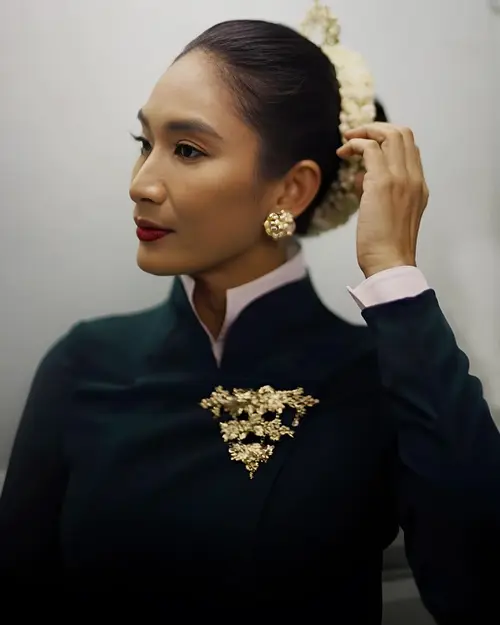
Image courtesy of Gadis Kretek (2023)
Traditional Busanas of Indonesia
When the topic of fashion is brought up in modern Indonesia, we are greeted with an array of styles that have been fused with those from other countries. Our regular attire has been reduced to a simple shirt and trousers; this is known as clothing, or pakaian in Indonesian. Although people from the capital city and/or other major cities have adopted a modern approach to styling themselves, this is not always the case for residents from other parts of the archipelago.
The current fashion term can be translated as busana in our language. It is shown as ordinary everyday attire, yet the word busana has a different connotation than pakaian, or clothing. According to Shinta Fitria Dewi, an author, a busana must be attractive to the eye as well as harmonizing to the person and occasion of usage. Following this, we can gain a better understanding of the meaning of the phrase busana adat (traditional clothing). Because Indonesia is made up of several ethnic and racial groups, there is a wide range of traditional attire available, including busana Jawa, busana Sunda, busana Betawi, and others.
Kebaya and Kebaya Janggan
The kebaya is a popular busana that we are all familiar with. During the National Revolution era, recognized by President Soekarno in the 1940s, it became known as an official state or national costume. A kebaya is a women's upper garment that is usually long-sleeved, sometimes embellished with sequins, and worn with a long skirt made of traditional kain. This is the most prevalent style of kebaya, and among the many variations, a specific one that has been emerging among Indonesian celebrities and famous personalities hails from Kraton Jogja, or the Royal Palace of Yogyakarta.

Image courtesy of Karaton Ngayogyakarta Hadiningrat
Known as an attire for the abdi dalem estri (a female courtier who dedicates themselves to the palace and the king), kebaya janggan is a model of clothing that is similar to a men's surjan (male courtiers' clothing in the Kraton), but the buttons on the shirt are from the neck down of the left side of the body, equipped with buttons that cover the neck. Janggan is derived from the word jangga, which means leher or the neck. The significance of the neck is highlighted in this term since leher denotes several things, including the divinity, beauty, and purity of women in the palace, Java, and in general. In current times, the kebaya janggan is also known as janggan hitam (black janggan), because the color black also has profound importance. Black denotes God's tenacity, simplicity, and humility, as well as His holy and pious nature.
Contemporary Revival
Images courtesy of Dikha Dheansa (Marsha Timothy)
and Vanesa Martida (Happy Salma)
In recent times, numerous public figures have taken to social media, posting themselves in attire that brings to mind the kebaya janggan. Images of well-known figures in the entertainment industry, elegantly clad in strikingblack tops and jarik, adorn numerous lists celebrating 'iconic kebaya janggan moments' on the internet.
These outfits have been skillfully crafted by the New York-based fashion house KRATON, which draws inspiration from Indonesian culture in creating their pieces. However, it's important to clarify that these outfits, while bearing a resemblance to the traditional kebaya janggan, are not strict interpretations. The same deep, enchanting dark hue and inherent elegance that adorn well-loved personalities such as Dian Sastro, Marsha Timothy, Happy Salma, Yuni Sarah, Adinia Wirasti, and others, are similar to kebaya janggan at best.
Interestingly, many fashion enthusiasts perceive these creations as either a kebaya janggan, or a harmonious blend of kebaya janggan elements and the beskap, a traditional Javanese male suit, all with a contemporary twist. KRATON’s designer, Auguste Soesatro, has expressed his admiration for the concept of crossdressing, specifically where women embrace men’s attire or more masculine silhouettes such as the beskap. Numerous anecdotes indicate that his iconic pieces lean more towards beskap than kebaya janggan, as evidenced by explanations in the captions of his muses' social media posts and his previous exhibition.
In summary, the enduring tradition of women wearing clothing with traditionally masculine features, as seen in the kebaya janggan resembling the surjan, remains relevant in today's fashion landscape. This proves fashion's ability to adapt and signifies a broader shift in society, where women confidently break away from traditional gender norms through their clothing choices, uniting tradition and modernity in the evolving world of fashion.
.png)







Comments